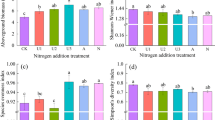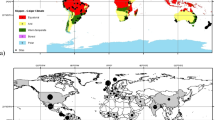Abstract
Post-clearcut silvicultural treatments, to improve tree growth and reduce salal (Gaultheria shallon) competition, were established in five different forest blocks on northern Vancouver Island, in 1984. Plots were either left untreated, brushed of competing salal vegetation, fertilized [(250 kg N + 100 kg P) ha-1], or brushed + fertilized. Three of these blocks were revisited 13 years later, in the summer of 1997, and various chemical, biochemical and microbial parameters were measured in forest floor humus samples to determine long-term effects of treatments on nutritional site quality. Brushing resulted in lower humus pH and extractable base cations, whereas fertilization increased Bray-extractable P. Over a 20-week aerobic incubation, significantly more N was mineralised in humus from fertilized plots than from brushed plots. Over a 14-d anaerobic incubation, significantly more N was mineralised in humus from the fertilized treatment than other treatments. Similarly, gross transformation rates of NH4 +and NO3 -, measured by 15N-dilution, were higher in humus from the fertilized treatment than other treatments. Ecophysiological indices of microbial communities (basal respiration, specific death rate, metabolic quotient, and energy deficiency index), derived by humus respirometry, suggested that there was higher available C in fertilized and brushed + fertilized treatments than in the brushed and control treatments. Total microbial biomass was equal to C-limited microbial biomass, which further confirmed that available C was the growth-limiting factor for microbial communities in all treatments. The prokaryotic fractions of microbial biomass in all treatments were approximately equal (≈ 65%). PCA ordination of microbial communities, based on C source utilisation patterns, showed a distinct clustering of humus samples taken from one of the sites. Within the cluster of samples taken from the other two sites, samples from fertilized plots scored separately from those from control plots. In salal foliage, concentrations of condensed tannins were higher in brushed and control plots than in fertilized and brushed + fertilized plots. In spite of other studies that have reported increased tree height following fertilization and/or removal of salal, results of the present study suggest improvement in nutritional site quality occurs only with fertilization, whereas brushing may in fact be detrimental. The long-term growth of hemlock observed in fertilized plots may be the result of changes to key ecosystem structures and processes brought about by increased speed of succession and accelerated canopy closure.
Similar content being viewed by others
References
Anderson T-H and Domsch K H 1978 A physiological method for the quantitative measurement of microbial biomass in soil. Soil Biol. Biochem. 10, 215–221.
Anderson T-H and Domsch K H 1990 Application of ecophysiological quotients (qCO2 and qD) on microbial biomasses from soils of different cropping histories. Soil Biol. Biochem. 22, 251–256.
Barker J 1988 Control of salal with Garlon. Expert Committee on Weeds. Reseach Report. p. 194. Western Canada Section Meeting. Winnipeg.
Beare M H, Neely C L, Coleman D C and Hargrove W L 1990 A substrate-induced respiration (SIR) method for measurement of fungal and bacterial biomass on plant residues. Soil Biol. Biochem. 22, 585–594.
Bending G D and D J Read 1996 Nitrogen mobilization from protein-polyphenol complex by ericoid and ectomycorrhizal fungi. Soil Biol. Biochem. 28, 1603–1612.
Bennett J 1996 fertilization and salal removal for improving conifer regeneration on CH sites. In Salal Cedar Hemlock Integrated Research Program. Research Update #1. Ed. CE Prescott. pp 8–15.Faculty of Forestry, University of British Columbia, Vancouver, B.C.
Bradley R L and Fyles J W 1995a A kinetic parameter describing soil available carbon and its relationship to rate increase in C mineralization. Soil Biol. Biochem. 27: 167–172.
Bradley R L and Fyles J W 1995b Growth of paper birch (Betula papyrifera) seedlings increases soil available C and microbial acquisition of soil nutrients. Soil Biol. Biochem. 27, 1565–1571.
Bradley R L and Fyles J W 1996 Method to avoid isotope discrimination during the diffusion of NH4 + from 15N-labelled soil extracts. Soil Biol. Biochem. 28, 695–697.
Bradley R L, Titus B D and Fyles J W 1997 Nitrogen acquisition and competitive ability of Kalmia angustifolia L., paper birch (Betula Papyrifera Marsh.) and black spruce (Picea mariana (Mill.) B.S.P.) seedlings grown on different humus forms. Plant Soil 195, 209–220.
Bradley R L, Titus B D and Preston C M (In press) Changes to mineral N cycling and microbial communities in black spruce humus after additions of (NH4)2SO4 and condensed tannins extracted from Kalmia angustifolia and balsam fir. Soil Biol. Biochem.
Bryant J P, Chapin F S III and Klein D R 1983 Carbon/nutrient balance of boreal plants in relation to verterbate herbivory. Oikos 40, 357–368.
Chang S X, Weetman G F and Preston C M 1996a Understory competition effect on tree growth and biomass allocation on a coastal old-growth forest cutover site in British Columbia. For. Ecol. Manag. 83, 1–11.
Chang S X, Preston C M, McCullough K, Weetman G F and Barker J 1996b Effect of understory competition on distribution and recovery of 15N applied to a western red cedar-western hemlock clearcut site. Can. J. For. Res. 26, 313–321.
Chen H Y H, Klinka K and Kabzems R D 1998 Site index, site quality, and foliar nutrients of trembling aspen: relationships and predictions. Can. J. For. Res. 28, 1743–1755.
De Montigny L E and Weetman G F 1990 The effects of ericaceous plants on forest productivity. In The Silvics and Ecology of Boreal Spruces. Eds. BD Titus, MB Lavigne, PF Newton and WJ Meades. pp 83–90. IUFROWorking Party S1.05-12 Symposium Proceedings. St. John's, Newfoundland.
Espeleta E E G and Mize C W 1993 A quantitative model for relating species and tropical forest sites - a synecological study. Rev. Biol. Trop. 41, 7–21.
Fraser L R, Turkington R and Chanway C P 1993 The Biology of Canadian Weeds. 102. Gaultheria-Shallon Pursh. Can. J. Plant Sci. 73, 1233–1247.
Fyles J W and Fyles I H 1992 Interaction of Douglas-fir with red alder and salal foliage litter during decomposition. Can. J. For. Res. 23, 358–361.
Gebauer R L E, Strain B R and Reynolds J F 1998 The effect of elevated CO2 and N availability on tissue concentrations and whole plant pools of carbon-based secondary compounds in loblolly pine (Pinus taeda). Oecologia, 133, 29–36.
Gracia M and Retana J 1996 Effect of site quality and thinning management on the structure of holm oak forests in Northeast Spain. Annal. Sci. For. 53, 571–584.
Haeussler S, Coates D and Mather J 1990 Autecology of common plants in British Columbia: a literature review. FRDA report #158, Victoria.
Halvorson J J, Smith J L and Papendick R I 1996 Integration of multiple soil parameters to evaluate soil quality - a field example. Biol. Fertil. Soils 21, 207–214.
Hart S C, Stark J M, Davidson E A and Firestone M K 1994 Nitrogen mineralization, immobilization and nitrification. In Methods of Soil Analysis. Part2: Microbial and Biochemical Properties. Eds. R W Weaver, chair S Angle, P Bottomley, D Bezdicek, S Smith, A Tabatabai, A Wollum. pp 985–1016. Soil Science Society of America, Inc., Madison.
Hester A J, Miles J and Gimingham C H 1991 Succession from heather moorland to birch woodland. I. Experimental alteration of specific environmental conditions in the field. J. Ecol. 79, 303–315.
Iason G R and Hester A J 1993 The response of heather (Calluna vulgaris) to shade and nutrients - predictions of the carbonnutrient balance hypothesis. J. Ecol. 81, 75–80.
Insam H and Haselwandter K 1989 Metabolic quotient of the soil miroflora in relation to plant succession. Oecologia 79, 174–178.
Keenan R J, Prescott C E and Kimmins J P 1993 Mass and nutrient content of the forest floor and woody debris in western red cedar and western hemlock forests on northern Vancouver Island. Can. J. For. Res. 23, 1052–1059.
Keenan R J, Messier C and Kimmins J P H 1994 Effects of clearcutting and soil mixing on soil properties and understorey biomass in western red cedar and western hemlock forests on northern Vancouver Island, Canada. For. Ecol. Manag. 68, 251–261.
Keenan R J, Prescott C E, Kimmins J P, Pastor J and Dewey B 1996 Litter decomposition in western red cedar and western hemlock forests on northern Vancouver Island, British Columbia. Can. J. Bot. 74, 1626–1634.
Kirkham D and Bartholemew W V 1954 Equations for following nutrient transformation in soil, utilizing tracer data. Soil Sci. Soc. Am. J. 18, 33–34.
Lewis T 1982 Ecosystems of the Port McNeil block (block 4) of Tree Farm License 25. Internal Report. Western Forest Products Ltd., Vancouver, B.C.
Messier C 1993 Factors limiting early growth of western red cedar, western hemlock and sitka spruce seedlings on ericaceousdominated clearcut sites in coastal British-Columbia. For. Ecol. Manag. 60, 181–206.
Messier C and Kimmins J P 1991 Above-and belowground vegetation recovery in recently clearcut and on burned sites dominated by Gaultheria shallon in coastal British Columbia. For. Ecol. Manag. 46, 275–294.
Messier C, Honer T W and Kimmins J P 1989 Photosynthetic photon flux density, red:far-red ratio, and minimum light requirement for survival of Gaultheria shallon in western red cedar - western hemlock stands in coastal British Columbia. Can. J. For. Res. 19, 1470–1477.
Myrold D D 1987 Relationship between microbial biomass and a nitrogen availability index. Soil Sci. Soc. Am. J. 51, 1047–1049.
Powers R F 1980 Mineralizable soil nitrogen as an index of nitrogen availability to forest trees. Soil Sci. Soc. Am. J. 44, 1314–1320.
Prescott C E and Weetman G F (Ed) 1994 Salal Cedar Hemlock Integrated Research Program: A synthesis. Faculty of Forestry. University of B.C. Vancouver, B.C.
Preston C M 1999 Condensed tannins of salal (Gaultheria Shallon Pursch): A contributing factor to seedling ‘growth-check’ on Northern Vancouver Island? In Plant Polyphenols 2: Chemistry, Biology, Pharmacology, Ecology (Eds. G G Gross, R W Hemingway and T Yoshida), Kluwer Academic/Plenum Publishers, New York. pages 825–841.
Sparling G P 1992 Ratio of microbial biomass carbon to total soil organic carbon as a sensitive indicator of changes in soil organic matter. Austr. J. Soil Res. 30, 195–207.
Thompson W A and Weetman G F 1992 Operational fertilization of young stands of cedar, hemlock and spruce on Northern Vancouver Island: Five year results and projected economic impact.Report to the B.C. Ministry of Forests. 51 p.
Tiarks A E, Bridges J R, Hemingway R W and Shoulders E 1989 Condensed tannins in southern pines and their interactions with the ecosystem. In Chemistry and Significance of Condensed Tannins. Eds. RW Hemingway and JJ Karchesy. pp 369–390. Plenum Press, New York.
Tietima A and Wessel W W1992 Gross nitrogen transformations in the organic layer of acid forest ecosystems subjected to increased atmospheric nitrogen input. Soil Biol. Biochem. 24, 943–950.
Wang G G 1998 Is height of dominant trees at a reference diameter an adequate measure of site quality ? For. Ecol. Manag. 112, 49–54.
Wang G G and Klinka K 1996 Use of synoptic variables in predicting white spruce site index. For. Ecol.Manag. 80, 95–105.
Wang G G, Marshall P L and Klinka K 1994 Height growth pattern of white spruce in relation to site quality. For. Ecol. Manag. 68, 137–147.
Waring S A and Bremner J M 1964 Ammonium production in soil under waterlogged conditions as an index of nitrogen availability. Nature 201, 951–952.
Weetman G F, Fournier R, Barker J and Schnorbus-Panozzo E 1989 Foliar analysis and response of fertilized chlorotic western hemlock and western red cedar reproduction on salal-dominated cutovers on Vancouver Island. Can. J. For. Res. 19, 1512–1520.
Rights and permissions
About this article
Cite this article
Bradley, R.L., Titus, B.D., Preston, C.M. et al. Improvement of nutritional site quality 13 years after single application of fertiliser N and P on regenerating cedar-hemlock cutovers on northern Vancouver Island, B.C.. Plant and Soil 223, 197–208 (2000). https://doi.org/10.1023/A:1004896116130
Issue Date:
DOI: https://doi.org/10.1023/A:1004896116130




